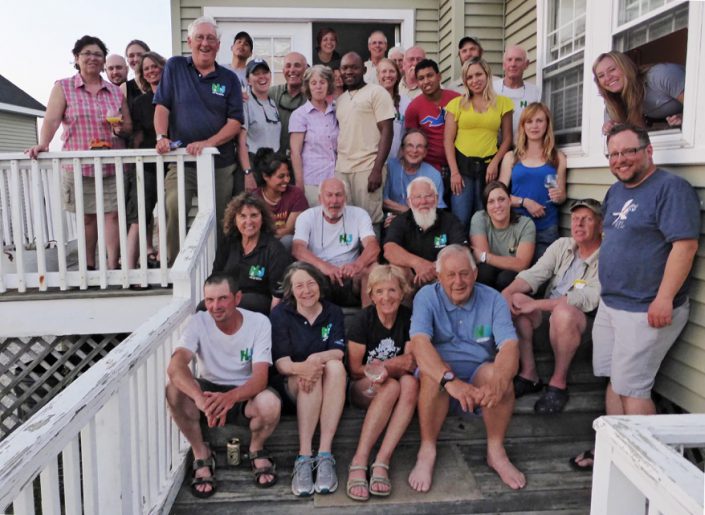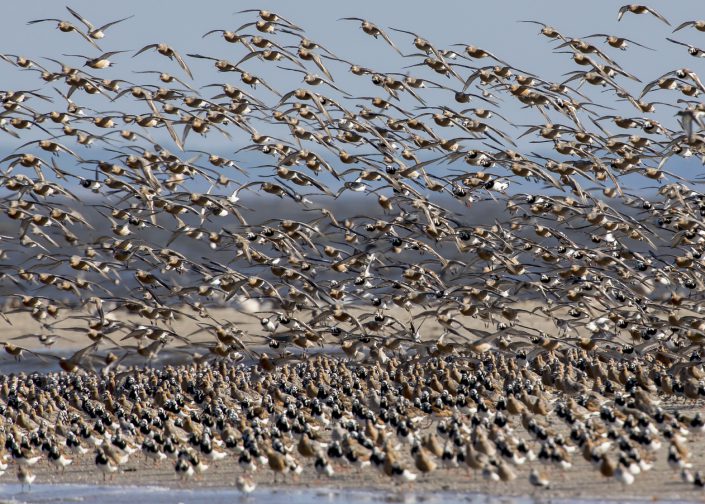20 Years of Conservation
Delaware Bay Shorebird Project Begins 20th Season
By: Dr. Larry Niles, LJ Niles Associates LLC
We begin the 20th year of the Delaware Bay Shorebird Project this year with many of the same team members that helped start the project in 1997. That’s 20 years of studying one of the most intellectually challenging and endlessly fascinating species of wildlife in the world. Few have had the good fortune to do so.

Unfortunately, we do not start this year with the same shorebird population. In the last twenty years, the Delaware Bay stopover fell precipitously from its once lofty perch as one of the top three stopovers in the world. Where once we counted over 1.5 million shorebirds, we now see less than 400,000, a sweet number but far less than the bay’s heyday. Red knot numbers have crashed from over 90,000 to a low of only 13,000. Ruddy Turnstones, the virtual working man of shorebirds, fell from 135,000 to just over 16,000. In this time, many intrepid shorebirds came to the bay to find succor provided by a once endless bounty of horseshoe crab eggs only to find empty beaches and no way back to their Arctic home.
Much of this was caused by short-sighted decisions made by the commercial fishing industry in the 1990’s, which decided to spend this bay’s natural (and publicly owned) wealth of horseshoe crabs. They needed bait and relentlessly pursued the crabs. Horseshoe crab populations fell to a quarter of their historic number and may have been driven to extinction without the work of the bay’s conservationists who fought bravely and with determination to stop them. Atlantic sturgeon, weakfish, herring, eels, and many of the bay’s once abundant fisheries weren’t so lucky.

Now a new industry, the oyster aquaculture industry, wants to consume another public natural resource, the bay’s intertidal flats. Cultivating oysters on metal racks placed on the bay’s extensive tidal flats is cheap and easy when you can use public trust lands. The expansion got a vital assist from the state agencies who side lined crucial environmental reviews to determine impact to species like the red knot, and required no public hearing, comment period or the involvement of any shorebird experts. This could have been corrected when the red knot was federally listed.

Unfortunately, the red knot’s federal listing has not helped in this controversial expansion of aquaculture. Instead, it proposed growers should be compensated for economic losses caused by the listing, and allowed the controversial expansion despite the obvious impacts to birds and crabs. Such decisions speak to Desperate Environmentalism, a term coined by Yale School of Forestry’s Joshua Galperin, describing the increasingly fraught position of conservationists who feel they must play ball with politically powerful industries or lose all. This desperate conservation could have been avoided if growers and conservationists worked together to expand aquaculture without significant impacts — because after all everybody loves oysters!

But this dark cloud cannot diminish the progress made by our team and groups like American Littoral Society and Conserve Wildlife Foundation of New Jersey. Just one example is the successful effort to restore horseshoe habitat on 2.7 miles of Delaware Bay horseshoe crab breeding habitat. The effort, funded by National Fish and Wildlife Foundation and the U.S. Fish and Wildlife Service, overcame the damage caused by Hurricane Sandy and prevented what could have been another shorebird disaster. This work has blossomed over the last four years into a network of activities that provides new hope for a long term protection of the bay. This conservation is not desperate but inspirational for hundreds biologists, land managers and volunteers.

So our 20th year is much like our first year, a group of conservation-minded shorebird scientists and volunteers gathering to help these poor birds find a way to make it home. As with most conservation stories in this time, it’s a David and Goliath story that hopefully has the same result.

Dr. Larry Niles has led efforts to protect red knots and horseshoe crabs for over 30 years.
Discover more from Conserve Wildlife Foundation of NJ
Subscribe to get the latest posts sent to your email.
Leave a Comment
I question your comment: “Unfortunately, the red knot’s federal listing has not helped in this controversial expansion of aquaculture. Instead, it proposed growers should be compensated for economic losses caused by the listing, and allowed the controversial expansion despite the obvious impacts to birds and crabs.”
Can you provide any scientific evidence that aquaculture negatively impacts either the crab spawning or the red knot feeding?
It’s a shame it took Super storm Sandy for groups to wake up and take action against the loss of beaches on the Delaware Bay.Commercial Fisherman have been watching this for years and nobody took action. Maybe if this was started sooner the crabs and knots wouldn’t be in the condition they are now.
With out beaches they crabs can’t spawn and the birds don’t eat.
To say that aquaculture is going to cause the down fall of the knots is absurd.I attended many meetings to get where we are with the regulations we have and at 99% of the meetings all interested parties were involved.
When the first Aquaculture zone was put in place NJ DEP non game was part of a contract with growers and the state. They were suppose to provide the monitoring of the Zone. They have never produced a report, noting,this is going on ten years now with no report.
We should be working together and allowing the science to govern. We are in the second year of a three year study by Rutgers to find out the true impacts.
This type of reporting does noting but create distrust among all involved and needs to stop.
If you are all educated people is science not what you are suppose to follow and without it what do you have.
What we have are people making statements without that knowledge.
I certainly agree that environmentalists could work with oyster growers to find common ground where both oysters and birds flourish. I have invited you, Larry, and your wife, Amanda from NJDEP, as well as people from Audubon and American Littoral Society to come down and visit my oyster farm and talk. Not one person has taken me up on my invitation. With the exception of American Littoral Society nobody bothered to reply at all. Furthermore, I have not seen you at any of the many meetings which I attended as the Conservation Measures for growers were being hashed out.
The invitation is still open and right now you can see for yourself the abundance of horseshoe crabs around my oyster racks and on the beach in front of them.
These comments were submitted by members of the aquaculture community and point to their own view of the conflict over red knots and aquaculture. Shorebird experts were not part of the dialogue leading to the measure adopted by the state and federal agencies. The original regulations that set up the conflict were submitted as an”emergency” under other regulations adopted as part of the response to Hurricane Sandy. The aquaculture permit was allowed to be adopted despite the absence of an emergency and without any environmental review. This was developed by the growers through Rutgers Extension and Shellfisheries section of NJ Division of Fish and Wildlife. Staff of the Rutgers Extensions were also part of the group of entrepreneurs that received permits. They were also now the only group sanctioned by the agencies to review impact. At no point in this process were shorebird experts allowed to express their view, either directly or indirectly as there was no public comment period nor public hearing as the agencies gave away this public trust resource.
Comments are closed.